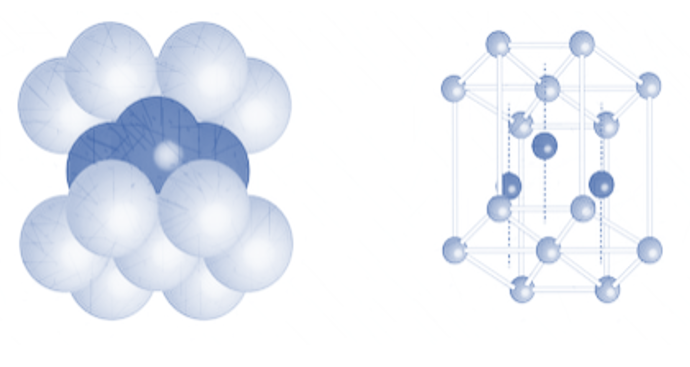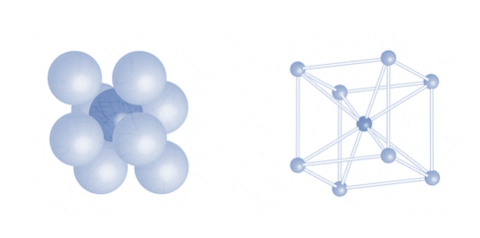
The ABAB packing and ABCABC packing are respectively called as:
A. Hexagonal close packing (hcp) and cubic close packing (CCP)
B. Cubic close packing (ccp) and hexagonal close packing (HCP)
C. Body centred cubic (bcc) and hexagonal close packing (HCP)
D. Hexagonal close packing (hcp) and body centred cubic (BCC)
Answer
215.7k+ views
Hint: The different packing structures or types can be identified on the basis of the molecular arrangement in the given lattice. Each type of packing structure has a unique arrangement of atoms within them that can be understood by viewing the lattice from a side profile.
Complete Step-by-Step answer:
The spatial arrangements of atoms within a given lattice can be done in one dimension or two dimensions or even in 3 dimensions. Cubic close packing (ccp), hexagonal close packing (hcp) and body centred cubic (bcc) are all 3-dimensional spatial arrangements.
The spatial arrangements for the given packing structures are given as follows:
1. Hexagonal close packing

The arrangement in hexagonal packing as observed above is ABABAB
2. Cubic close packing

Face centred cubic packing is also known as cubic close packing. The arrangement in hexagonal packing as observed above is ABCABC
3. Body centred cubic packing

Since the body centric atoms are not in contact with any other atom within the same 2 – dimensional layer, it cannot be defined using a layer by layer interpretation.
Hence, the ABAB packing and ABCABC packing are respectively called as hexagonal close packing (hcp) and cubic close packing (ccp)
Hence, Option A is the correct option.
Note: The repetitive patterns of the different 2 - dimensional layers of the packing structures are named A, B, C and so on. So, each type of dimensional packing structure, has its own repetitive arrangements of the 2 - dimensional layers which can be represented in the above fashion.
Complete Step-by-Step answer:
The spatial arrangements of atoms within a given lattice can be done in one dimension or two dimensions or even in 3 dimensions. Cubic close packing (ccp), hexagonal close packing (hcp) and body centred cubic (bcc) are all 3-dimensional spatial arrangements.
The spatial arrangements for the given packing structures are given as follows:
1. Hexagonal close packing

The arrangement in hexagonal packing as observed above is ABABAB
2. Cubic close packing

Face centred cubic packing is also known as cubic close packing. The arrangement in hexagonal packing as observed above is ABCABC
3. Body centred cubic packing

Since the body centric atoms are not in contact with any other atom within the same 2 – dimensional layer, it cannot be defined using a layer by layer interpretation.
Hence, the ABAB packing and ABCABC packing are respectively called as hexagonal close packing (hcp) and cubic close packing (ccp)
Hence, Option A is the correct option.
Note: The repetitive patterns of the different 2 - dimensional layers of the packing structures are named A, B, C and so on. So, each type of dimensional packing structure, has its own repetitive arrangements of the 2 - dimensional layers which can be represented in the above fashion.
Recently Updated Pages
Alpha, Beta, and Gamma Decay Explained

Alpha Particle Scattering and Rutherford Model Explained

Angular Momentum of a Rotating Body: Definition & Formula

Apparent Frequency Explained: Formula, Uses & Examples

Applications of Echo in Daily Life and Science

Atomic Structure Explained: Key Concepts for Students

Trending doubts
JEE Main 2026: Application Form Open, Exam Dates, Syllabus, Eligibility & Question Papers

JEE Main Correction Window 2026 Session 1 Dates Announced - Edit Form Details, Dates and Link

Derivation of Equation of Trajectory Explained for Students

Hybridisation in Chemistry – Concept, Types & Applications

Understanding the Angle of Deviation in a Prism

Understanding Collisions: Types and Examples for Students

Other Pages
NCERT Solutions For Class 12 Chemistry Chapter 1 Solutions - 2025-26

NCERT Solutions for Class 12 Chemistry Chapter Chapter 7 Alcohol Phenol and Ether

NCERT Solutions ForClass 12 Chemistry Chapter Chapter 8 Aldehydes Ketones And Carboxylic Acids

JEE Advanced Marks vs Ranks 2025: Understanding Category-wise Qualifying Marks and Previous Year Cut-offs

Haloalkanes and Haloarenes Class 12 Chemistry Chapter 6 CBSE Notes - 2025-26

Solutions Class 12 Chemistry Chapter 1 CBSE Notes - 2025-26




